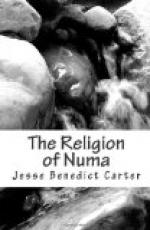In this connection it is interesting to notice two facts which stand almost as corollaries to these beliefs. One fact is the religious necessity for the continuance of the family, in order that there might always be a living representative of the family to perform the sacrifices to the ancestors. It was the duty of the head of the family not only to perform these sacrifices himself as long as he lived but also to provide a successor. The usual method was by marriage and the rearing of a family, but, in case there was no male child in the family, adoption was recurred to. Here it is peculiarly significant that the sanction of the chief priest was necessary, and he never gave his consent in case the man to be adopted was the only representative of his family, so that his removal from that family into another would leave his original family without a male representative. In cases of inheritance the first lien on the income was for the maintenance of the traditional sacrifices unless some special arrangement had been made. These exceptional inheritances, without the deduction for sacrifices, were naturally desired above all others and the phrase “an inheritance without sacrifices” (hereditas sine sacris) became by degrees the popular expression for a godsend. The other fact of interest in this connection is that, inasmuch as ancestors were worshipped only en masse and not as individuals, that process could not take place in Roman religion which is so familiar in many other religions, namely that the great gods of the state should some of them have been originally ancestors whose greatness during life had produced a corresponding emphasis in their worship after death, so that ultimately they were promoted from the ranks of the deified dead into the select Olympus of individual gods. This has been a favourite theory of the making of a god from the time of Euhemerus down to Herbert Spencer. There are religions in which it is true for certain of the major gods, but there are no traces of the process in Roman religion, and the reason is obvious in view of the peculiar character of ancestor worship in Rome.




